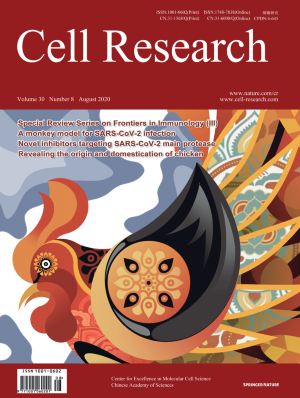
Advanced Search
Submit Manuscript
Advanced Search
Submit Manuscript
Volume 30, No 8, Aug 2020
ISSN: 1001-0602
EISSN: 1748-7838 2018
impact factor 17.848*
(Clarivate Analytics, 2019)
Volume 30 Issue 8, August 2020: 670-677 |
Infection with novel coronavirus (SARS-CoV-2) causes pneumonia in Rhesus macaques
Chao Shan1,2,†,* , Yan-Feng Yao1,† , Xing-Lou Yang1,† , Yi-Wu Zhou3,† , Ge Gao1 , Yun Peng1 , Lian Yang4 , Xue Hu1,2 , Jin Xiong1 , Ren-Di Jiang1,5 , Hua-Jun Zhang1 , Xiao-Xiao Gao1 , Cheng Peng1 , Juan Min1 , Ying Chen1,5 , Hao-Rui Si1 , Jia Wu1 , Peng Zhou1 , Yan-Yi Wang1 , Hong-Ping Wei1 , Wei Pang6 , Zheng-Fei Hu7 , Long-Bao Lv7 , Yong-Tang Zheng6 , Zheng-Li Shi1,* , Zhi-Ming Yuan1,*
1Center for Biosafety Mega-Science, Wuhan Institute of Virology, Chinese Academy of Sciences, Wuhan, Hubei 430071, ChinaThe 2019 novel coronavirus (SARS-CoV-2) outbreak is a major challenge for public health. SARS-CoV-2 infection in human has a broad clinical spectrum ranging from mild to severe cases, with a mortality rate of ~6.4% worldwide (based on World Health Organization daily situation report). However, the dynamics of viral infection, replication and shedding are poorly understood. Here, we show that Rhesus macaques are susceptible to the infection by SARS-CoV-2. After intratracheal inoculation, the first peak of viral RNA was observed in oropharyngeal swabs one day post infection (1 d.p.i.), mainly from the input of the inoculation, while the second peak occurred at 5 d.p.i., which reflected on-site replication in the respiratory tract. Histopathological observation shows that SARS-CoV-2 infection can cause interstitial pneumonia in animals, characterized by hyperemia and edema, and infiltration of monocytes and lymphocytes in alveoli. We also identified SARS-CoV-2 RNA in respiratory tract tissues, including trachea, bronchus and lung; and viruses were also re-isolated from oropharyngeal swabs, bronchus and lung, respectively. Furthermore, we demonstrated that neutralizing antibodies generated from the primary infection could protect the Rhesus macaques from a second-round challenge by SARS-CoV-2. The non-human primate model that we established here provides a valuable platform to study SARS-CoV-2 pathogenesis and to evaluate candidate vaccines and therapeutics.
https://doi.org/10.1038/s41422-020-0364-z